
Mathematical ImageryMathematical artists create strong, stunning works in all media and explore the visualization of mathematics
2009 Mathematical Art Exhibition
The Mathematical Art Exhibition held at the 2009 Joint Mathematics Meetings in Washington, DC, included 49 works in various media by 36 artists. Robert Fathauer was the curator of the exhibition, and the exhibition website was prepared by Anne Burns. The exhibition was juried by Fathauer and Burns, along with Nat Friedman and Reza Sarhangi. The inaugural Mathematical Art Exhibition Prizes were awarded. Four judges, selected by the American Mathematical Society and the Mathematical Association of America, made the following awards: First Prize to Goran Konjevod, for his origami work, "Wave (32), 2006;" Second Prize to Carlo Séquin, for his sculpture, "Figure-8 Knot, 2007;" and Third Prize to Robert Fathauer, for "Twice Iterated Knot No. 1, 2008." The Prize "for aesthetically pleasing works that combine mathematics and art" was established in 2008 through an endowment provided to the American Mathematical Society by an anonymous donor who wishes to acknowledge those whose works demonstrate the beauty and elegance of mathematics expressed in a visual art form.
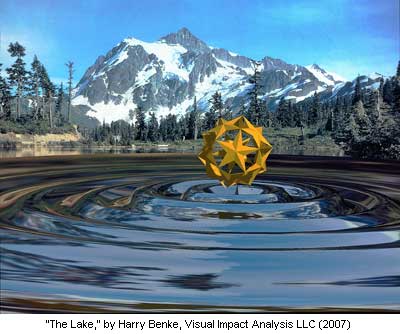
Digital C-print (laser exposed photographic paper, i.e. Lightjet print), 15" x 12". "'The Lake' is an object rising from ripples in a lake. The object is formed by placing 5 pointed stars on the transparent faces of a dodecahedron. The sine wave and harmonic ripples in the lake as well as the dodecahedron elements are rendered 3D models. The models are digitally composed with a scanned background. The mountains could also be fractal and algorithmically generated, but in this work the mountains are part of the base background scan which gives a better sense of depth to the artwork." --- Harry Benke

Archival digital print, 19" x 13.6". "'Totem' represents the frontier, the uncharted, the often surprising and almost mystic nature of mathematical discovery. The totem is composed of ellipsoids $x^2/a^2+y^2/b^2+z^2/c^2 = 1$, ray-trace rendered over an algorithmically generated fractal skyscape. Atmospheric effects were calculated as well such as scattering, moisture etc. The totem signifying the last guidepost to the unknown." --- Harry Benke
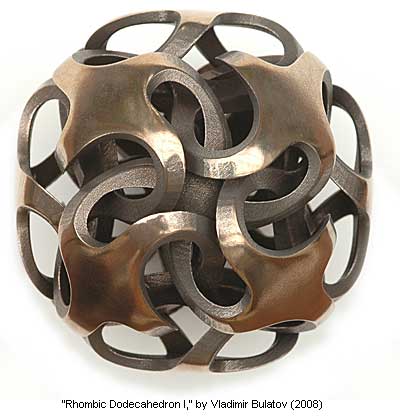
Metal sculpture, 4.5" diameter. "The base of this sculpture is rhombic dodecahedron (polyhedron with 12 rhombic faces with cubical symmetry). Each of the 12 faces was transformed into a curved shape with 4 twisted arms, which connects to other shapes at vertices of valence 3 and 4. The boundary of the resulting body forms quite a complex knot. My artistic passions are purely mathematical images and sculptures, which express a certain vision of forms and shapes, my interpretations of distance, transformations and space. In my opinion, mathematics is not simply a profession, but rather a way of thinking, a way of life." --- Vladimir Bulatov
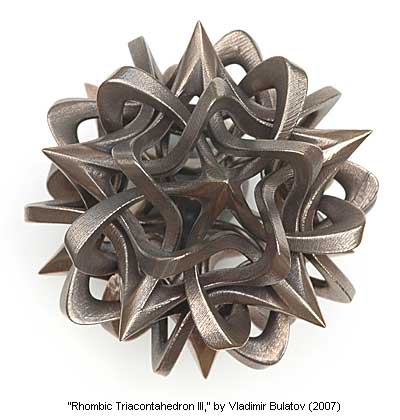
Metal sculpture, 4.0" diameter. "Stellation of rhombic triacontahedron with 30 identical rhombic faces makes base for this sculpture. All internal intersections of rhombic faces were carefully eliminated by cutting away parts of rhombuses. The resulting 3D body was given organic shape by replacing straight faces with smooth subdivided surface. My artistic passions are purely mathematical images and sculptures, which express a certain vision of forms and shapes, my interpretations of distance, transformations and space. In my opinion, mathematics is not simply a profession, but rather a way of thinking, a way of life." --- Vladimir Bulatov

Digital print, 13" x 12". "This is an iterated function system made up of Mobius Transformations, programmed in ActionScript. I began my studies as an art major; later I switched to mathematics. In the 1980's I bought my first computer and found that I loved programming and could combine my all of my interests: art, mathematics, computer programming and nature." --- Anne Burns
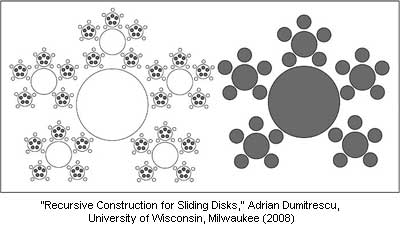
Digital print, 11" x 5". "Given a pair of start and target configurations, each consisting of n pairwise disjoint disks in the plane, what is the minimum number of moves that suffice for transforming the start configuration into the target configuration? In one move a disk slides in the plane without intersecting any other disk, so that its center moves along an arbitrary (open) continuous curve. One can easily show that 2n moves always suffice, while the above construction shows pairs of configurations that require 2n-o(n) moves for this task, for every sufficiently large n. Disks in the start configuration are white, and disks in the target configuration are shaded. " --- Adrian Dumitrescu
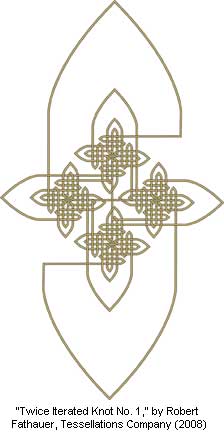
Third Prize, 2009 Mathematical Art Exhibition. Digital print, 19" x 12".
"The starting point for this iterated knot is a nine-crossing knot that has been carefully arranged to allow seamless iteration. Four regions of this starting knot are replaced with a scaled-down copy of the full starting knot, incorporated in such a way that the iterated knot is still unicursal. These same four regions are then replaced with a scaled-down copy of the iterated knot, resulting in a complex knot possessing self similarity." --- Robert Fathauer
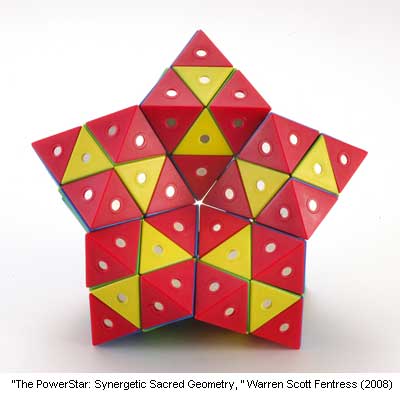
MagneBlocks, 20" x 20" x 20". "Platonic fundamental shapes like the tetrahedron and pyramid, which are culminated recursively into 'powered tetrahedrons & pyramids', are arranged into pentagonal forms that mimic the 5-fold geometry of flowers. I invented MagneBlocks because of the bicameral mind resonating with the fundamental consciousness waveforms that permeate spacetime." --- Warren Scott Fentress
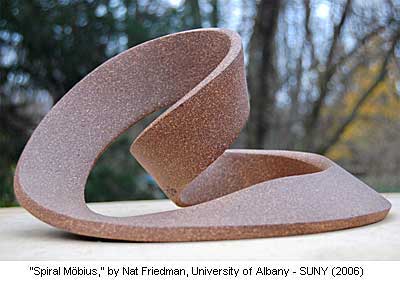
Stoneware, 12" x 8" x 12". "This sculpture was made by starting with a cut circular band of clay and then bending and twisting before rejoining the cut ends. Props were used to preserve the shape while drying. The form was then sanded, low fired, sanded, and then high fired." --- Nat Friedman
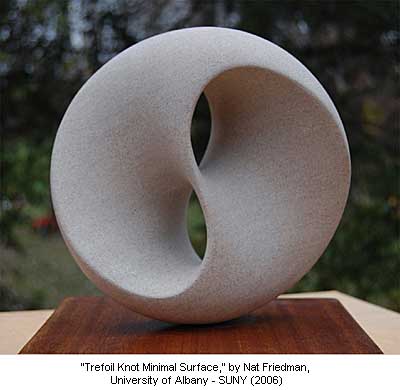
Limestone, 9" diameter by 4" depth. "This sculpture was carved from a circular piece of limestone. The form is based on the shape of the soap film minimal surface on a configuration of a wire trefoil knot. There is a nice interaction of the form and space with light and shadow." --- Nat Friedman
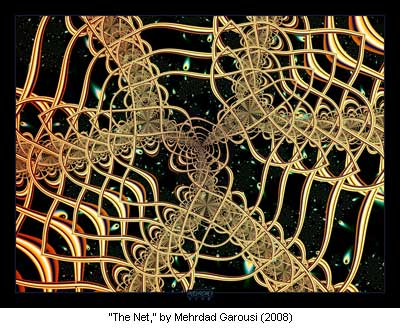
Digital art print, 24" x 18.5". "This image exhibits a very complex, yet ordered series of lonely fibers that are woven in each other. This generated lacy net is not flat and goes to infinity at the center and also many times in each of its main arms. Another wonderful mathematical and artistic representation is where hexaploid weaving is modified into a triple one without cutting or deleting any fibers. Self similarity is the main property of this work, as any small hole in the main arms is nearly similar to the whole image. Having experimented with other media, I chose mathematical fractal image making as one of the newest and most wonderful common areas between mathematics and art." --- Mehrdad Garousi
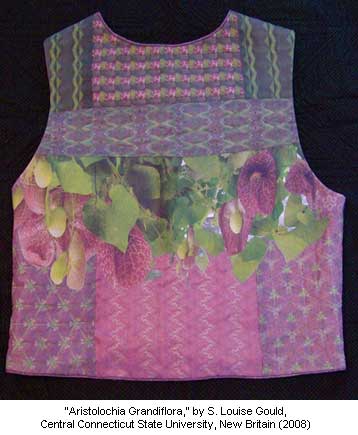
Inkjet print on treated silk, quilted and sparsely beaded to emphasize symmetries, 20" x 21.5". "My artwork usually connects textiles or paper with mathematical, specifically geometric ideas. 'Aristolochia Grandiflora' is a floral fractal. When I first saw the plant at Frederik Meijer Gardens in Grand Rapids in full bloom in May, it seemed a natural subject for exploring the seventeen wallpaper patterns in the plane. Starting with a photograph that I had taken in the garden, I sampled sections of the plant image and used KaleidoMania to generate samples of each of the seventeen wallpaper patterns. These were printed on 8.5 by 11 inch treated silk pages and folded, cut, pieced, quilted and beaded to create mathematical art to wear." --- S. Louise Gould
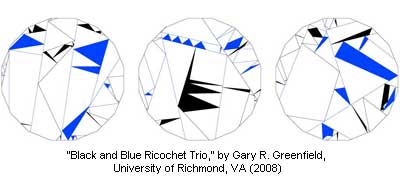
Digital print, 14" x 24". "Many of my computer generated algorithmic art works are based on visualizations that are inspired by mathematical models of physical and biological processes. These three side-by-side black and blue "ricochet compositions" were generated by placing particles on each of the sides of a 16-gon, assigning them starting angles, and then letting each move in a straight line until it encounters an existing line segment at which point it is reflected--the ricochet--and then paused so that the next particle may take its turn. Further, if a particle ricochets off its own path, then the area it has just enclosed is filled using the requisite black or blue drawing color that particles were alternately assigned." --- Gary R. Greenfield
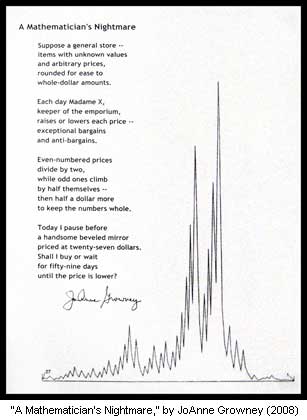
Laser print on paper, 15 1/2" x 17 1/2" . "The poem, 'A Mathematician's Nightmare,' introduces a version of the unsolved Collatz Conjecture which asserts that when prescribed operations are iterated on any positive integer, the sequence produced will eventually reach 1. The prescribed operations are these, for any starting positive integer $n$: if $n$ is even, replace $n$ by $n/2$ (i.e., decrease $n$ by half); if $n$ is odd, replace $n$ by $(3n+1)/2$ (i.e., increase $n$ by half and round up to the next integer); my exhibit-entry displays both the poem and a graph of the sequence of iterations applied to the integer 27." --- JoAnne Growney
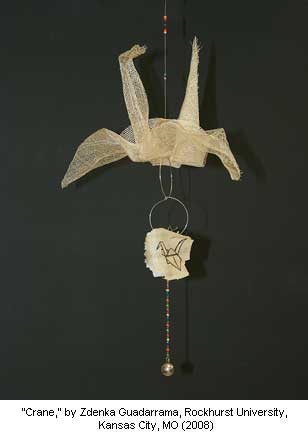
Mobile--Gauze, papyrus, silver and wood, 10" x 10" x 15". "'Crane' represents the continuous dimensional transition from a point, represented by a silver sphere, to a line, a plane and finally a crane. This transition is depicted in parallel to the evolution of the creative process which starts with an idea, represented by the same silver sphere, and which through refinements and trials culminates in the bird as well. [My] projects consist in artistic explorations that happen in parallel to the teaching/learning of mathematics (measure theory or complex analysis, for example). I search to generate art using mathematics and art inspired in the mathematics that I share with my students in order to motivate them to learn more mathematics, to make some extra connections, and to create some art of their own." --- Zdenka Guadarrama
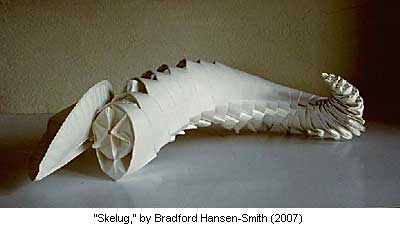
28 folded circles, 16"x6"x5". "Nine inch paper plate circles are folded and reformed into multiple units that have been arranged in one of many possible combinations of joining. Consistently following the development it began to take on a skeleton-like appearance and by decreasing the diameters of the circles it began to form a twisting conical helix, much like a sea slug, thus the name Skelug. Most all of my explorations with the circle start with folding three diameters, developing the equilateral triangular grid, reforming and joining multiples, which often reveals structural forms observable in nature." --- Bradford Hansen-Smith
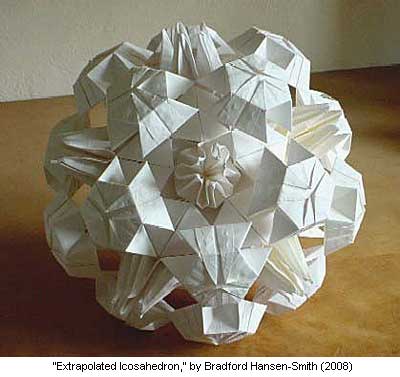
52 folded 9" paper plate circles, 13"x13"x13". "Forty circles have been folded, reformed to an in/out variation of a truncated tetrahedron, then octahedronally joined in pairs, and arranged in an icosahedron pattern. This revealed an interesting form of the icosadodecahedron with open pentagon stars. In this case twelve circles were reformed and added to suggest mouth-like openings found in sea anemones or in opening flower buds. This gives function to the open pentagons. Much of what I explore with folding circles are the structural functions of geometry found in life forms that correlate to the movement forms of the folded circle." --- Bradford Hansen-Smith
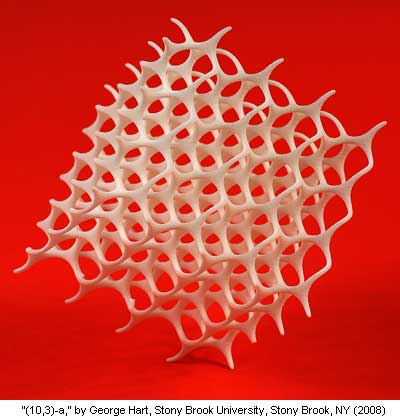
Nylon (selective laser sintering), 3.5" x 3.5" x 3.5". "This is a sculptural interpretation of the (10,3)-a crystal lattice, which has been well known to crystallographers and mathematicians for decades. However I have adapted it by wrapping it in a smooth surface which maintains its high genus topology while giving an organic sensibility. A 4x4x4 block has been selected from the infinite lattice in such a way that it can stand upright on a corner with a 3-fold axis vertical. Viewing the sculpture from different vantage points reveals a rich set of dramatically different tunnels along varying projections. See additional information and images." --- George Hart
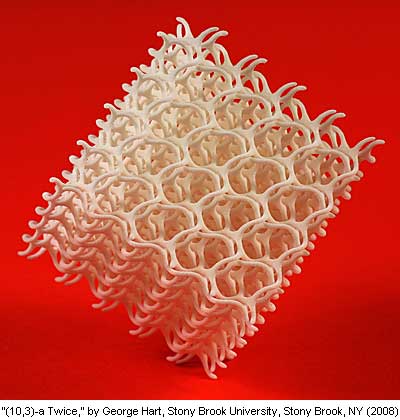
Nylon (selective laser sintering), 3.5" x 3.5" x 3.5". "This is a sculptural interpretation, made by selective laser sintering, of two copies of the (10,3)-a lattice. Modern layered fabrication processes allow the construction of two interlocked components which are free to move slightly relative to each other, within the constraints of their being linked. The two copies are congruent, though mirror images. Each interpenetrates the tunnels of the other in a surprisingly complex manner. The 5x5x5 selection from the infinite lattice was made in such a way that the sculpture can stand vertically on a corner. --- George Hart
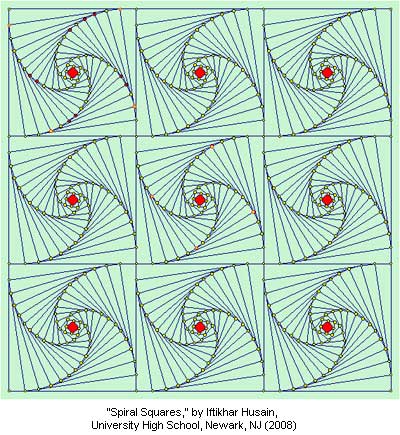
Digital print, 8" x 8". "The artwork 'Spiral Squares' was originally created on a TI-84 Plus graphing calculator. The design was uniquely created by using two equations only of linear function with restricted domain. These two equations have different parameters of the equation of each line segment, such as slope, y-intercept, domain x-left value, and domain x-right value, organized in a table. Each line segment is drawn by picking up its respected parameter value from the table. Once all the values from the table are exhausted the complete spiral square will appear on the calculator screen. The artwork is simple but truly illustrates the mathematical concepts. A single Spiral Square was then created on a computer using Geometer Sketchpad software. The artwork, shown here, is the simple translation effect of the single spiral square horizontally and vertically thrice." --- Iftikhar Husain
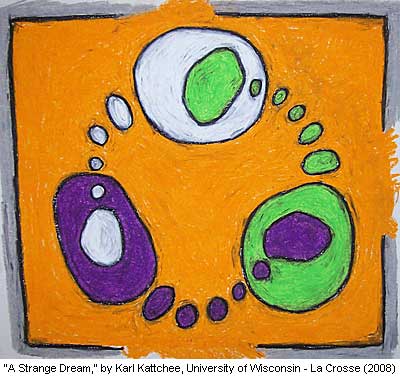
Oil crayon on paper, 20" x 24". "This drawing is composed of round shapes, mainly. The arrangement of the round shapes is itself round, so that roundness is occurring on multiple levels. On the other hand, the drawing depicts multiple levels of thinking or being, like a sleeper who dreams within his dream within his dream. A Strange Loop, in the sense of Hofstadter, is evident." --- Karl Kattchee
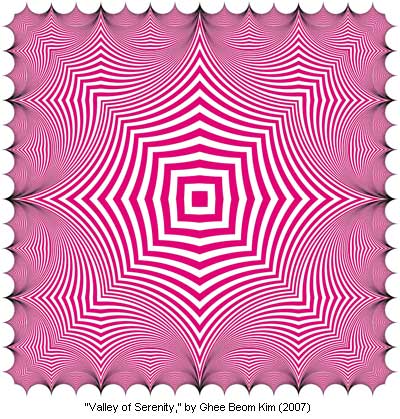
Digital print, 12" x 12". "'Valley of Serenity' has been created using semicircles based on fractal concept with a touch of Op art element. Within a semicircle two smaller semicircles fit in. This process (iteration) continues on until it is visually meaningful. The resulting image conjures up an extraterrestrial terrain of a faraway planet. The smaller semicircles bear a resemblance to a horizon by giving it the effect of perspective." --- Ghee Beom Kim
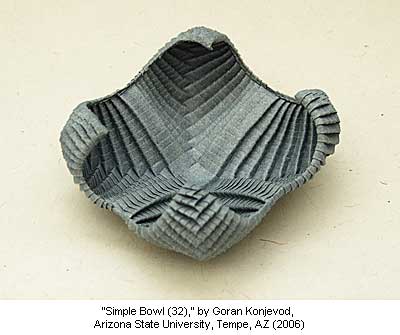
One folded square sheet of paper, 5" x 5" x 4". "This is one of the simplest pieces in my ongoing series of bowls formed by pleat tessellations. Every fold is a straight line segment parallel to an edge of the square sheet, and no fold is ever undone. The curved surface is purely a result of the intrinsic tension in the sheet of paper trying to unfold itself. This simple bowl is constructed by using alternating pairs of vertical and horizontal pleats, from the edges toward the center." --- Goran Konjevod
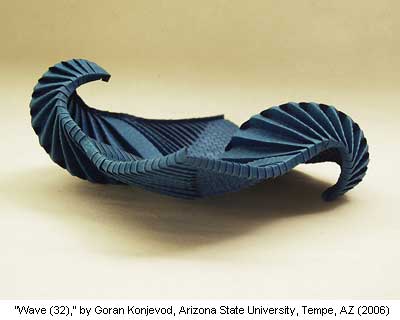
First Prize, 2009 Mathematical Art Exhibition.
One folded square sheet of paper, 10" x 10" x 5". "The wave is one of the pleat tessellations that continues to amaze me even years after I first folded it. The peculiar symmetry and the tension caused by locking the edges causes two of its corners to bulge in opposite directions, while the remaining two corners remain fairly flat. As in the simple bowl, the pleat sequences all begin at the edges and proceed towards the center of the sheet, but the difference is that all horizontal pleats are oriented the same way, and similarly all the vertical pleats." --- Goran Konjevod
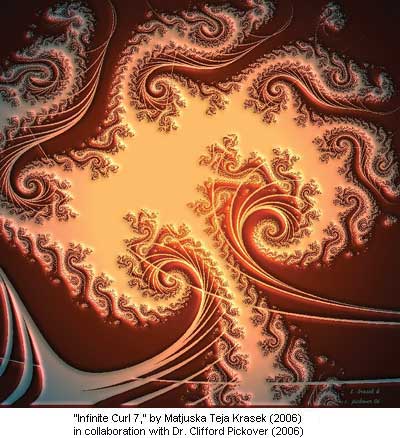
Digital print, 9.9" x 10.1". "The image represents the behavior of mathematical feedback loops, and more particularly the iteration of a complex function. The figure is our rendition of a visually interesting quartic variant of a Ushiki Phoenix Julia set. As with other fractals, the image exhibits a wealth of detail upon successive magnifications. The image "Infinite Curl 7" has been made in collaboration with Dr. Clifford Pickover, the author of more than thirty books about mathematics, art, and science." --- Matjuska Teja Krasek
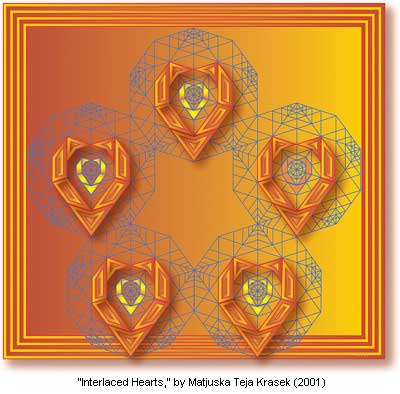
Digital print, 12.6" x 11.9". "The implicit decagon constituted of five smaller decagons expresses tenfold and fivefold rotational symmetry. The image where golden heart-like shapes are exposed shows self-similarity, the richness of relations between the decagons, pentagonal stars, Penrose rhombs, kites and darts with the golden ratio used several times as a scale factor." --- Matjuska Teja Krasek

Digital print, 20" x 20". "This is a Klein diagram (named after the nineteenth-century German mathematician Felix Klein) that represents A5, the group of symmetries of the icosahedron. Another way of describing A5 is as the alternating group on five elements, namely, the group of all even permutations of five entities. This diagram emphasizes A5's tetrahedral subgroup A4 (the group of symmetries of the tetrahedron, also the group of even permutations of four entities), which has twelve elements, plus the four left cosets of A4. The general diagram is obtained by centrally projecting an icosahedron onto a sphere (with the center of one face projected onto the north pole) and then making a stereographic projection of the sphere down onto a horizontal plane. Each coset has been identified with one color. The circle contains a hundred and twenty regions from which sixty correspond to the dark blue background, and the other sixty are split with the five left cosets. The reason I have realized Klein diagrams is to understand more clearly the beauty of Group Theory." --- Francisco Lara-Dammer
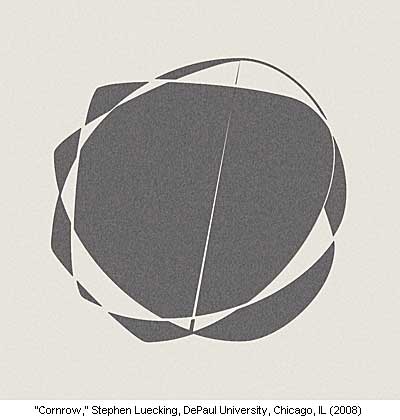
Giclee print, 13" x 13". "Images begin as super ellipses constructed from bezier curves in which the weight and position of the control points are randomized, using a random number generator to induce eccentricity. The eccentric curves are then layered subjected to various improvised Boolean and path edits. The results are not intended to be read as mathematical objects, thus the randomizing and improvising procedures. Rather the goal is to seek out visual tensions implicit in the relationship between the curves and the tondo format, between the wholeness of the circle and the fragmentation in its interior." --- Stephen Luecking

Giclee print, 13" x 13". "Images begin as super ellipses constructed from bezier curves in which the weight and position of the control points are randomized, using a random number generator to induce eccentricity. The eccentric curves are then layered subjected to various improvised Boolean and path edits. The results are not intended to be read as mathematical objects, thus the randomizing and improvising procedures. Rather the goal is to seek out visual tensions implicit in the relationship between the curves and the tondo format, between the wholeness of the circle and the fragmentation in its interior." --- Stephen Luecking
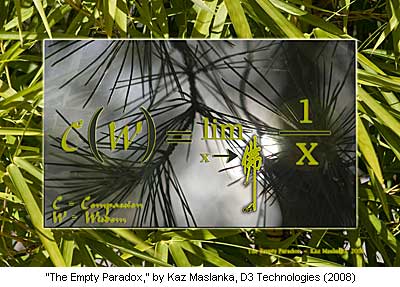
Digital print, 16" x 20". "The equation is the familiar function of x equal to 1/x which yields a hyperbolic curve when graphed and results an asymptote when x = 0. Compassion multiplied by Wisdom is equal to 1 over X as the limit of X approaches Buddha's mind. Buddhist philosophy tells us that Buddha's mind is emptiness yet the philosophy also tells us that emptiness is different than nothingness or zero. In fact it is quite paradoxical for we are told that emptiness is very much something. This piece also uses visual imagery for poetic expression with Buddhist symbolism of flexibility and eternity represented by bamboo and pine trees respectively. As an artist, my interest in correlating experience through language spawned my desire to study mathematics and physics. I am currently pursuing my interest in using mathematics as a language for art." --- Kaz Maslanka
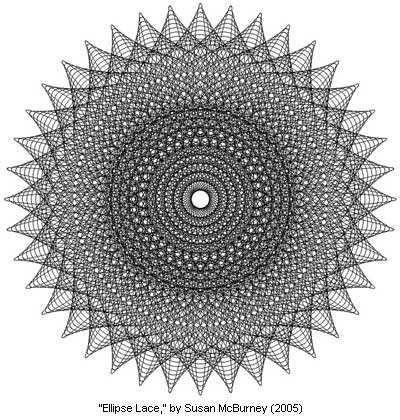
Computer-generated graphic art; digital print, 14" x 14". "This complex and intricate design is created very simply from just one element--the ellipse. The width and height are varied and the sets are rotated, but the result is not at all what one might expect. In particular, the interior circles are generated entirely by the interaction of the parts. There are no circles drawn at all and the complexity of the design is entirely natural and unpredicted. It is my intention to use the computer as a tool to generate designs that are not only aesthetically pleasing, but that also reveal the order, structure and beauty inherent in mathematical objects. Additionally, if an attractive design can be made from the simplest of elements, then the generating process itself becomes an object of beauty as well. Complexity from a simple beginning via an elemental algorithm is a common, fascinating and universal process." --- Susan McBurney
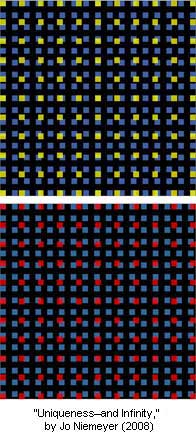
Prints, 20" x 20". "To realize the concept of 'uniqueness' in art is a true challenge. And no easy task for an artist. This could be said for the concept 'infinity' as well. As a visual experiment with both of them, this problem is shown systematically in two steps in the following two graphics: The top image shows the overlapping of two geometrical grids. The size of the mesh corresponds to the relation 1 : 0.625. Or the Fibonacci numbers 5 and 8. There are nine grid elements, which overlap accurately. Furthermore the constellations of overlappings reiterate themselves. The two grids behave periodically. There is infinity - but no uniqueness. The bottom image shows the overlapping of two grids as well. Very similar to the top image, but the size of their meshes correspond here exactly to the relation of the golden section. 1 : 0.6180339... As the last number is an irrational number, the two grids behave aperiodically. Only the upper left two grid elements overlap accurately. Each overlapping constellation of the elements is unique, even if the size of the grid would be extended to infinity!" --- Jo Niemeyer
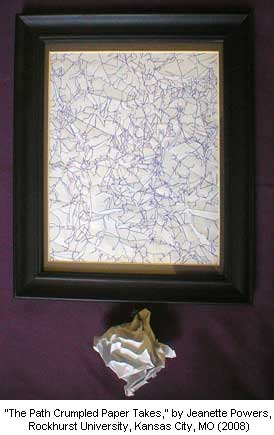
Ink and paper, 11" x 15". "A classic example to explain fractal dimension is the piece of crumpled paper. In this example, one takes a sheet of paper to be 2 dimensional (ignoring the very thin thickness). This then is a good representation of the mathematical plane. However, if we crumple the paper into a ball, as seen below the frame, it seems to take on a volume, or third dimension. Now, there is a meta-level to the inter-dimensionality of this system. If one flattens the paper back into the two dimensional sheet of paper, then one can draw a continuous line (in blue) of all the folds that happened during the crumpling process. Now a line is considered to be one dimensional, but is the space this line takes up really best described with only one dimension?" --- Jeanette Powers
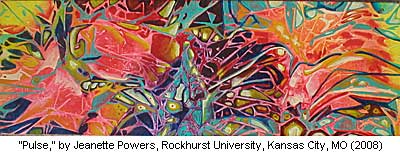
Acrylic, 6" x 24". "This piece explores Hausdorff Dimension. Chaos and dynamical systems collapse in ordered ways. A nebula coalescing into a galaxy, a frozen molecule tossing through the tumult and falling as a six-sided crystal, the Mandelbrot Set. As an artist, I've tried to use chaotic interactions as a tool to express the limitations of our control and the beauty of chaos. This painting uses cellophane crushed into wet pigment to create the random patterning of the surface. The result is a chaotic landscape reminiscent of leaves, cells, rivulets, the cracked dirt of arid lands. All chaotic processes which leave a recognizable mark. The pattern is not exact, but exhibits self-similarity." --- Jeanette Powers
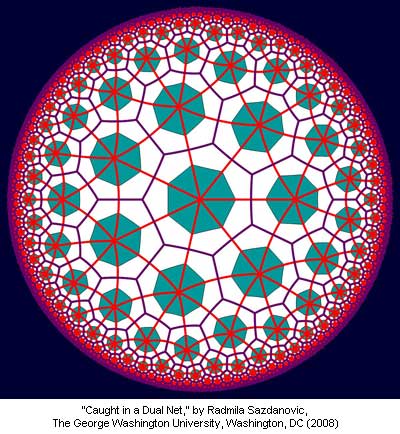
Digital print, 16" x 16". "This computer graphic represents three superimposed tessellations. The edges of a tessellation (6,6,7) are hidden below two nets consisting of tessellations (7,7,7) and (3,3,3,3,3,3,3), both dual to the original one. My inspiration stems from the rich geometric structures found in tessellations of the hyperbolic plane. Mathematical objects can be manipulated in many ways (superimposing, dualizing, breaking symmetry) to create aesthetically pleasing computer graphics brought to life by the unusual combination of colors." --- Radmila Sazdanovic
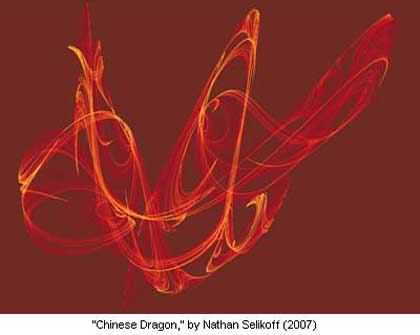
Lightjet print, 18" x 24". "Underlying this artwork is a two-dimensional plot of the 'typical behavior' of a chaotic dynamical system, a strange attractor. The base image is computed with a set of iterated functions, which serve as a numerical approximation to integrating the underlying differential equations. The iterated functions contain four coefficients, which are controlled by sliders in interactive custom software and control the appearance of the attractor. Once the particular form is chosen, it is rendered as a high-resolution 16-bit grayscale image, colorized using gradient mapping and edited to enhance contrast, control composition, and add special effects. I love experimenting in the fuzzy overlap between art, mathematics, and programming. The computer is my canvas, and this is algorithmic artwork--a partnership mediated not by the brush or pencil but by the shared language of software. Seeking to extract and visualize the beauty that I glimpse beneath the surface of equations, I create custom interactive programs and use them to explore algorithms, and ultimately to generate artwork." --- Nathan Selikoff
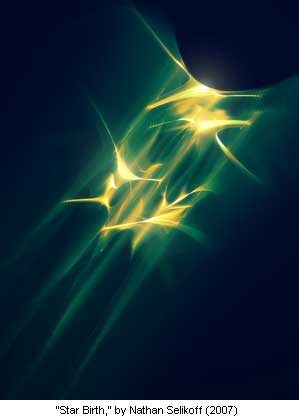
Lightjet print, 24" x 18". "Underlying this artwork is a two-dimensional plot of the 'typical behavior' of a chaotic dynamical system, a strange attractor. The base image is computed with a set of iterated functions, which serve as a numerical approximation to integrating the underlying differential equations. The iterated functions contain four coefficients, which are controlled by sliders in interactive custom software and control the appearance of the attractor. Once the particular form is chosen, it is rendered as a high-resolution 16-bit grayscale image, colorized using gradient mapping and edited to enhance contrast, control composition, and add special effects. I love experimenting in the fuzzy overlap between art, mathematics, and programming. The computer is my canvas, and this is algorithmic artwork--a partnership mediated not by the brush or pencil but by the shared language of software. Seeking to extract and visualize the beauty that I glimpse beneath the surface of equations, I create custom interactive programs and use them to explore algorithms, and ultimately to generate artwork." --- Nathan Selikoff
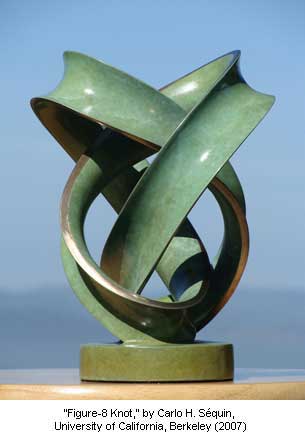
Second Prize, 2009 Mathematical Art Exhibit.
Bronze, 9" tall. "The Figure-8 Knot is the second simplest knot, which can be drawn in the plane with as few as four crossings. When embedded in 3D space it makes a nice constructivist sculpture. This particular realization has been modeled as a B-spline along which a crescent-shaped cross section has been swept. The orientation of the cross section has been chosen to form a continuous surface of negative Gaussian curvature." --- Carlo H. Séquin
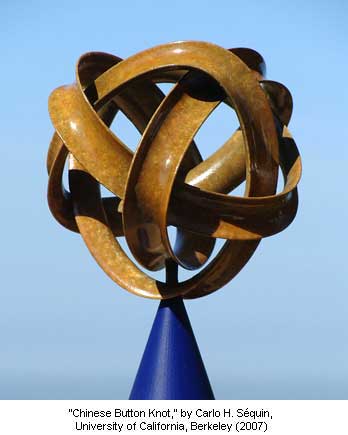
Bronze, 8" tall. "The Chinese Button Knot is a nine-crossing knot, number 9-40 in the knot table. It actually has more symmetries than one would infer from the usual depiction in these tables. This has been brought out in this 3D sculpture, which has one 3-fold and three 2-fold rotational symmetry axes. It has been implemented as an alternating over-under path on the surface of a sphere, realized by a ribbon of continuous negative Gaussian curvature." --- Carlo H. Séquin
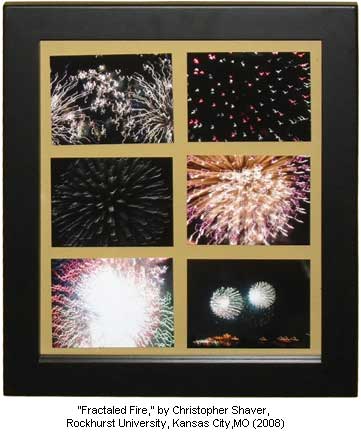
Digital photography, 11" x 14". "This work is a collage of photos taken during the fireworks display at Fair St. Louis on July 4, 2008. Each firework is somewhat self-similar and recursive in nature, with a common pattern appearing at both the center and the outer edges, and each piece having almost the same appearance. The shape is complex even on a small scale. The dimension of a firework is difficult to comprehend since its shape is constantly changing over time, but is a three-dimensional display. The change over time can be viewed and even is part of the overall image because of the appearance of the smoke left behind in the same shape as the colored flame. These art pieces are the product of a student research project I was a part of, exploring the relationship between art and math by a study of fractals." --- Christopher Shaver
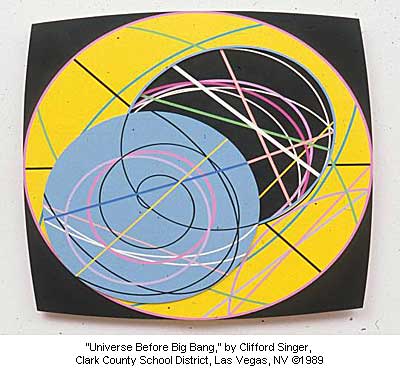
Acrylic on plexiglass, relief, 36" x 36" x 2". "This painting as a model entitled, Universe Before Big Bang, 1989, is intended to reconstruct the universe prior to the Big Bang. My concept in 1989 was to take a snapshot of the universe encapsulated in a non-Euclidean square. Thus, matter is then present before the Big Bang. Origins of the cosmos are found in supersymmetries and further understanding of concepts for their elucidation. As an artist and geometer 'infinity' has taken an important place in my life in terms of abstraction. My art combines both ancient and modern mathematical foundations ranging from Pythagoras to Einstein." --- Clifford Singer
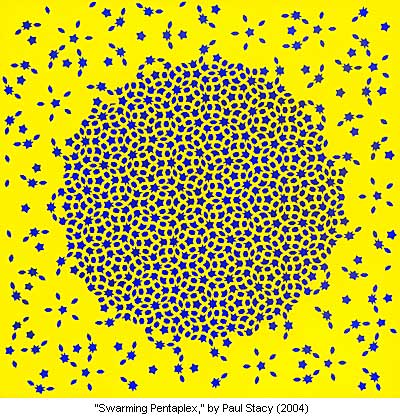
Glicee print on canvas (mounted) scanned from original artwork, acrylic paint on board, 20" x 20". "'Swarming Pentaplex' is a representation of the seven Penrose rhomb vertex groups, which I inadvertently "discovered" while experimenting with various matching rules. Of course the Penrose vertex groups have been long-known, however this exploded arrangement results from a very simple underlying tile decoration, with a gradual feathering out of the basic pattern. The resultant picture has great beauty inherent to pentagonal geometry with its aesthetic revelations of the "golden mean". The title refers to the fact that in the right half-light and standing at the right distance the painting comes alive with movement in waves across the canvas, like swarming bees! " --- Paul Stacy
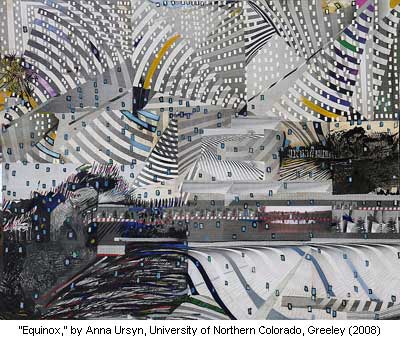
Fortran, photosilkscreens, photolithographs, photographs, etc., 8" x 10". "I explore dynamic factor of line. I find computers to be a perfect tool to explore the regularity of nature. I use the computer on different levels. First I draw abstract geometric designs for executing my computer programs. Then I add photographic content using scanners and digital cameras. The programs that produce two-dimensional artwork serve as a point of departure for photolithographs and photo silkscreened prints on canvas and paper. All of these approaches are combined for image creation with the use of painterly markings." --- Anna Ursyn
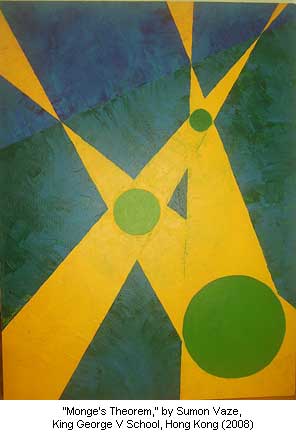
Acrylic on Canvas, 18" x 24". "The external tangents to three circles, taken in pairs, meet at three points, which are collinear. I seek to depict interesting mathematical truths, curiosities and puzzles in simple, visually descriptive ways. Mathematical amusements inspire the color and form in my paintings, and I try to strike a balance between the simplicity of the concepts and their depiction in art." --- Sumon Vaze
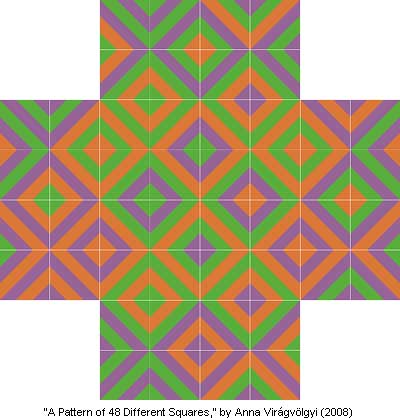
Digital print, 20" x 20". "This is a pattern of the 48 different squares, where the square sheets are striped diagonally, the stripes are colored by three colors such that the adjacent stripes are different color. Albeit the arrangement of the squares is not regular, since all the elements are different, the whole surface is symmetrical. Changing the neighborhoods of the elements engenders a different shape. There are innumerable patterns possible. (For example rectangles may be made--with matching opposite borders--which form tori.) The almost limitless solution patterns enhance cognitive skills." --- Anna Viragvolgyi
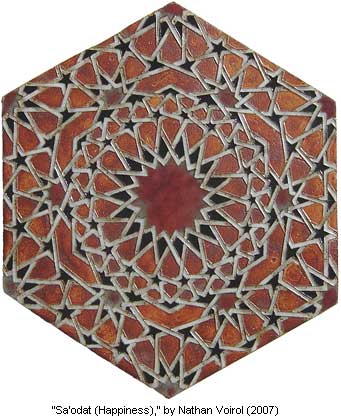
Hand-made ceramic tile, 15" diameter. "Islamic star pattern based on a tessellation of 18 and 12 pointed stars in a hexagonal repeat. My primary artistic interest is in designing repeatable patterns--I particularly enjoy creating geometric star and floral designs, which stem from my fascination with Islamic art." --- Nathan Voirol
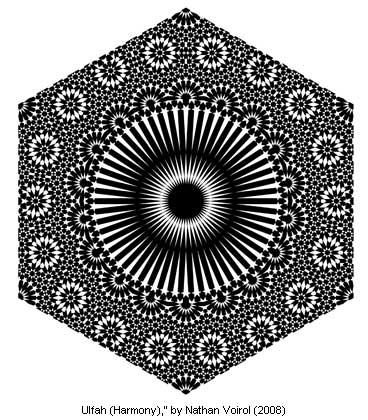
Silkscreen print on paper, 20" x 24". "Islamic star pattern based on a tessellation of a 54 pointed star surrounded by 9 and 18 pointed stars in a hexagonal repeat. My primary artistic interest is in designing repeatable patterns--I particularly enjoy creating geometric star and floral designs, which stem from my fascination with Islamic art." --- Nathan Voirol
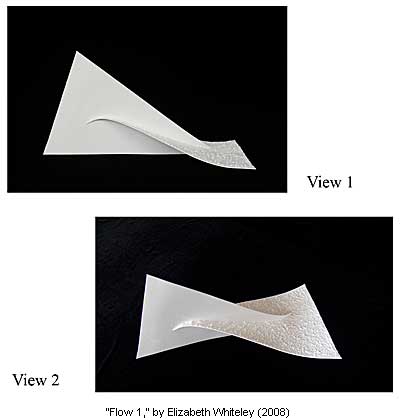
Laminated canvas and acrylic paint, 7.5" x 14" x 7.5". "'Flow 1' is created by intersecting two Golden Triangles (base angles of 72 degrees and vertex angle 36 degrees). The plane of each triangle is partially bisected and then curved to create an aesthetically pleasing form. One triangle is smooth; the other has a textured surface. The sculpture changes our perception of a static and planar geometric shape and makes for a dynamic visual experience. The curves move the eye around the form and suggest multiple points of view." --- Elizabeth Whiteley
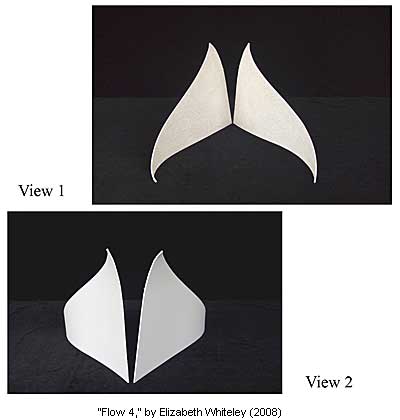
Museum board and acrylic paint, 7.5" x 13.5" x 10.5". "'Flow 4' is created by the close proximity of two Golden Triangles (base angles of 72 degrees and vertex angle 36 degrees). The plane of each triangle is curved in opposing directions to create an aesthetically pleasing form. The sculpture changes our perception of a static and planar geometric shape and makes for a dynamic visual experience. The curves move the eye around the form and suggest multiple points of view." --- Elizabeth Whiteley



